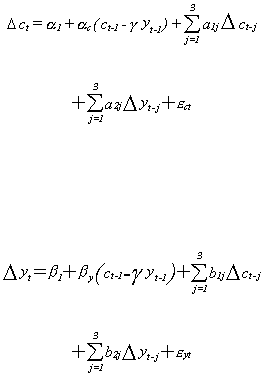From the web site you will fetch a file titled Y&NOND.DAT. It contains a column for the year (1947-1980) and a column for the quarter (1-4). The third column is income and the fourth is nondurable consumption. The data is in billions of 1982 dollars and has been deseasonalized.
1. Graph both income and nondurable consumption. Do the series appear to you to be stationary?
2. Take natural logs of both series; call them y and c respectively. Graph the transformed series. Do the new series appear to be stationary?
3. Estimate the parameters of

The intercept allows for drift in the process and the time variable allows for a deterministic trend. Use the regression results to test the following hypotheses:
a. There is neither drift nor deterministic trend.
b. There is a unit root in each of income and consumption.
4. Estimate the parameters of

Using this augmented Dickey-Fuller framework, comment on the stationarity of the Dct and Dyt series. On the basis of your work in this problem set, do you now believe that you may have run a spurious regression in an earlier homework assignment?
5. Estimate the parameters of the long run relationship
Call the residuals from this estimation
